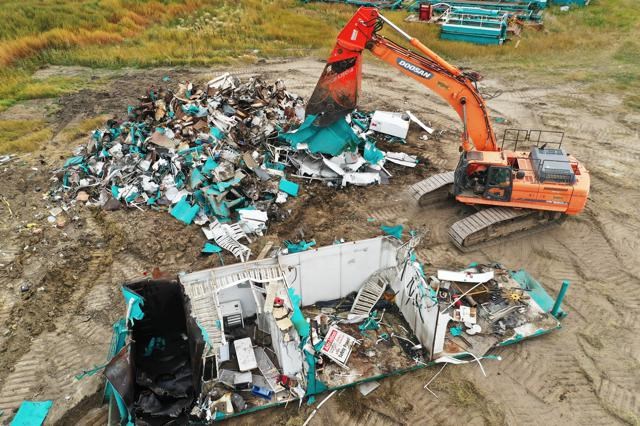Like a giant Tyrannosaurus Rex tearing through its prey, a 52-ton excavator equipped with large hydraulic shears tore through the last skid-mounted building of what was once a Saskatchewan-based drilling rig on Sept. 14. A hundred metres away, a large pile of tangled steel was once three complete drilling rigs, which used to punch through southeast Saskatchewan’s sedimentary rock to drill for black gold.
What was once the combo-building, complete with a locker room and microwave, was now torn to shreds, lying in Fast Trucking’s yard in Carnduff. Similar scenes had already taken place in Carlyle, and near Stoughton. Waskada, Manitoba, was next.
This summer, Ensign Energy cut up 10 Saskatchewan-based drilling rigs for scrap. Several of those rigs were Kelly telescopic doubles less than 15 years old. Several would have had less than 10 years service on them, as they’ve been racked for the last five years. They initially cost between $5 and $8 million a piece – built in Estevan during the Bakken boom. Now, they will be melted down at Regina’s EVRAZ steel mill. Some of those rigs could end up as casing pipe, used to line future holes drilled by the survivors of Saskatchewan’s drilling rig fleet.
Ensign Energy’s Aug. 10 second quarter results press release noted they had 118 “marketed rigs” in Canada in June 2019, and 101 in June 2020. Their U.S. rig count went from 134 to 122, and international rigs went from 42 to 43. Overall, the company’s marketed rig fleet shrunk by 10 per cent.
The reason is obvious. Work that has largely dried up since the downturn hit in late 2014 truly withered this year, with the advent of COVID-19 and its destruction of oil demand. Drilling activity in Saskatchewan flatlined at zero rigs working until mid-July, then ran around five rigs. Just in recent days, that number has climbed to 12 rigs working. In August, 2011, a record 122 rigs were working.
For the three months ending June 30, Ensign’s total drilling rig operating days dropped from 1,317 to 377 in Canada, a decline of 71 per cent. In the U.S. for the same period, operating days dropped from 6,451 to 2,214, or a fall of 66 per cent. International drilling rigs saw a 41 per cent decline in operating days, from 1,195 to 704.
“The financial results for the company’s Canadian operations decreased during the first half of 2020 primarily due to the oil price war and the impact of the COVID-19 pandemic on the global oil and natural gas industry as described above,” the release said.
For most of the last decade, Saskatchewan has had roughly 120 drilling rigs listed with the Canadian Association of Oilwell Drilling Contractors (CAODC). That number now stands at 96. The scrapping of 10 rigs represents roughly seven per cent of the fleet at full strength, and nine per cent for its more recent size.
According to Daily Oil Bulletin, in December, 2018, Ensign delisted 17 drilling rigs, including 14 mechanical telescoping doubles built between 1993 and 2011, with depth capacities ranging from 3,000 to 4,000 metres. Other recently-delisted Ensign rigs included two mechanical cantilever doubles (built in 1998) with 3,200- and- 3,500- metre depth capacities, respectively, and one mechanical cantilever triple built in 2005 with a 4,000-metre depth capacity.
In 2016, Ensign cut up 13 older rigs in southeast Saskatchewan. When they merged with Trinidad Drilling in early 2019, they acquired 13 additional rigs in the region. Now, they’ve cut up 10, most of which were part of that recent deal.
The rigs that have been cut up represent a varied history, as indicated by their paint schemes. Some are former Totem Drilling rigs, others are former Eagle Drilling rigs. At least one bore Trinidad’s teal paint, and another had Ensign’s dark blue.
Carnduff-based Totem Drilling started in 2006 with three rigs, its first few rigs С����Ƶ built in China, and the remainder in Canada, at Do-All Industries in Estevan. Its rigs were orange with a black stripe. Carlyle-based Eagle Drilling fired up in 2005, and all its eight yellow rigs were built in Estevan. The two local drillers were purchased by CanElson Drilling in 2010. In 2015, Trinidad Drilling bought CanElson, and it, in turn, was acquired by Ensign in a merger in February 2019.
During all this tumult in ownership, the oil downturn sidelined many of these rigs for the last five years. Five orange and yellow rigs were cut up in the former Eagle Drilling yard in Carlyle this summer. A former Totem rig, which hadn’t moved from the Crescent Point laydown yard northwest of Stoughton for at least five years, was cut up in place at that location. Three more rigs were cut up in Fast Trucking’s yard at Carnduff. The last rig to get chopped up by the giant metal shears was racked at Waskada, Manitoba.
Canada’s drilling rig fleet, which for several years numbered over 800 and would see over 600 working during the winter, now numbers 506. In 2006, that number was closer to 950. Where individual oil and gas companies would employ a dozen or even a half dozen each, on Sept. 14, employing just two rigs put your company in a six-way tie for С����Ƶ the fourth-most active oil company in the country. Hiring a single rig now qualifies you to tie for 10th�����������.




